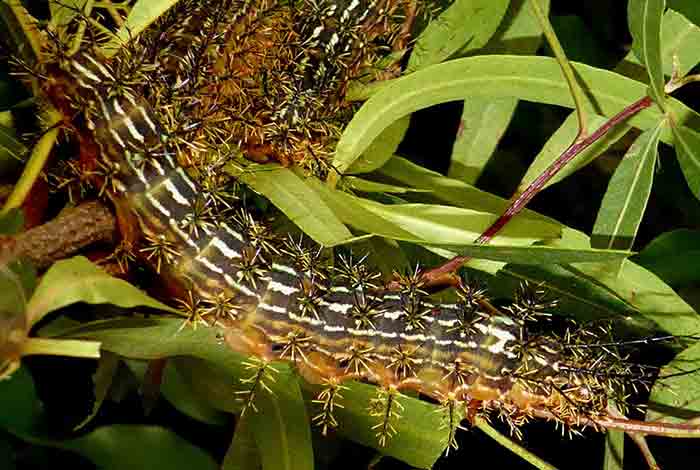Various questions run across householders’ minds whenever they spot moths. They often ask themselves whether the moths are dangerous, whether they bite, or whether they require treatment after moth infestation. There are various reasons moths are dangerous, considering that some lay eggs on food and clothes while others mess household items.
Table of Contents
Why are Moths Dangerous?
Moths are dangerous to pets and human beings since they contaminate human food and pet food. Adult moths tend to leave behind feces, eggs, and cocoons that remain after the caterpillar hatches.
Further Reading: Moth Life Cycle
When human skin or those of pets are exposed to these excretions, it results in allergic reactions and in other cases, mucosal irritations. Once pets and humans consume food contaminated by moths’ excretions, they are prone to intestinal infections.
The insects are dangerous since they spread rapidly, thus causing harm to both pets and human beings. They often invade all places and mainly prefer crevices, cracks, and holes found in ceilings and furniture.
They also infest hard to reach areas and being aggressive pests, can bite through plastic foils, and infest human food.
The giant silkworm moths found in South America, especially the Lomonia Achelous and Lonomia oblique species, while at the caterpillar stage, are lethal to human beings.

As a defensive mechanism, the spines of these species secrete venom that irritates human skin.The venom that they secret contains a potent anticoagulant.
Exposure to venom is known to result to decreased blood clotting leading to severe bleeding which may result to death, intense pain, bruises and other fatal effects. Fortunately, they’re harmless when the caterpillars develop to adults.
Some people consider moths to be a food source. Some African cultures consume moths and caterpillars, given that they are rich in healthy fats, proteins, potassium, zinc, iron, and calcium. There have been numerous cases of poisoning resulting from eating moths with few death cases reported, all these as a result of eating moths.
Do Moths Bite Humans and Pets
Most moth species do not have mouths but have a proboscis. The proboscis is usually weak and cannot puncture human and pet skin. These moth species suck on sweat excreted by human beings and pets. The reaction from sucking might be harmful and cause skin infections.
Some species such as Calyptra, which is mainly found in Europe have a special proboscis that is designed for piercing. They use the proboscis for sucking both human and pet blood. The secretions they leave on the skin after sucking blood lack an anticoagulant agent. However, the bites are harmless: they never cause skin irritations or swelling.
More Moth Damages
- The Brown house moth is known for scavenging food. They feast on various foods, such as grains and cereals when left exposed in houses.
- The clothes moth species larvae create holes in fabrics. They consume protein-based fibers such as silk and wool. They end up destroying carpets; rugs and clothes. They also destroy clothes by chewing them completely. This creates financial constraints. One is forced to either repair or replace the affected clothes.
- The Indian meal moth causes great damage to the food industry. They are synonymous with invading grain and cereal stores and often cause decay and leave infections. For industries that serve or process food, the moths often destroy large food containers. They end up destroying a company’s reputation once customers notice the presence of moths in their food.
- The Oak processionary moth is an invasive species. During their caterpillar stage, they emit toxic venom that causes health issues such as skin swelling, redness, and extreme skin irritation.
- Household moths tend to lay eggs on clothes and when spotted late, can leave spot marks on clothes. They can also invade households and cause substantial damage to property.
Frequently Asked Questions
Is it safe to touch a moth?
It is safe to touch most moths; however, some moth species are dangerous since once caught, they cause skin irritations.
The Hickory tussock moth has hair strands that normally irritate predators. Once the hairs from the moth land on human skin, they cause rashes. The hair strands also contain venom, which causes skin inflammation. It is always advisable to consult moth experts before handling either caterpillars or adult moths.
What can a moth do to you?
Moths are generally harmful to human beings. Their cocoons and feces usually contaminate food and once consumed, it results in stomach infections and illness. Making contact with infested fabrics or clothes often causes allergic reactions. Contact with moths should, therefore, be reduced.
Are moths Aggressive?
No, most moths are passive creatures. However, some rare moth species can be aggressive when attacked by predators. They react by emitting toxic fluids to predators thus keeping them at bay.
Do poisonous Moth Species exist?
Yes, as mentioned before, there is a variety of moth species that secrete toxic fluid. Other moths have dust on their wings that cause skin irritation and affect the health of human beings. The Oak Processionary Moth is a sample case study that can emit toxic venom that causes health issues such as skin swelling, redness, and extreme skin irritation.
What groceries do moths mainly infest?
Flour moths mainly infest nuts, all
types of flour and legumes. Household moths, on the other hand, infest cereals,
nuts, cocoa powder, dried fruit, and grains.
References
- https://entomology.ca.uky.edu/ef609
- http://www.scielo.br/scielo.php?lng=en
- https://www.connorspest.com/blog/mischievous-moths-in-virginia-and-the-damage-they-cause/
- https://entomologytoday.org/2017/03/23/up-close-and-personal-with-venomous-moths/
- https://www.karger.com/Article/PDF/48075
- https://www.rentokil.ie/blog/months-bite/
Further Reading